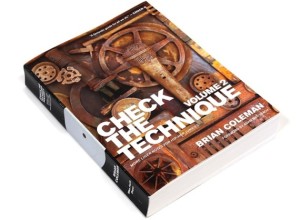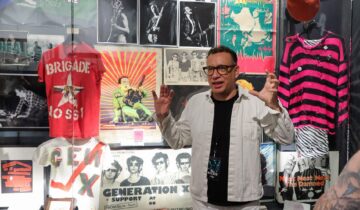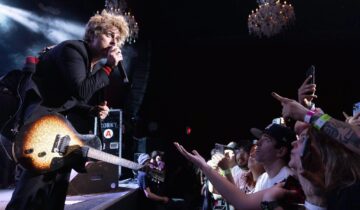 For the ATLANTIC: Journalist and author Brian Coleman investigates hip-hop in a specific way: He asks rappers to talk about how seminal hip-hop records were made, presses record, and lets the tape roll.
For the ATLANTIC: Journalist and author Brian Coleman investigates hip-hop in a specific way: He asks rappers to talk about how seminal hip-hop records were made, presses record, and lets the tape roll.
Why? Because liner notes are hard to come by in hip-hop, a genre whose stories have been “languishing behind closed lips,” in the words of author and screenwriter Adam Mansbach, who wrote the foreword to Coleman’s latest self-published book, Check the Technique Volume 2: More Liner Notes For Hip-Hop Junkies, 525 pages of oral history of 25 albums Coleman considers to be the most important in the development of the genre.
The book gets down to the minutia, the small details that casual fans may not know: Ice Cube guest-rapped on the Public Enemy song “Burn Hollywood Burn” from the group’s Fear of a Black Planet album because Chuck D had become a mentor to him, and Ice Cube happened to be in New York for Def Jam label meeting that never happened. Chuck D encouraged Ice Cube, who wanted to leave N.W.A. to go solo, to be able to “back up anything you say” and write all of his rhymes in notebooks. Ice Cube eventually filled up eight, 200-page notebooks in preparation for his solo debut.
Smooth Bee, of New York’s Nice & Smooth, caught his big break by working on early solo songs for Bobby Brown—recently defected from New Edition—simply because UTFO DJ Mix Master Ice couldn’t make it into the studio. “One minute I’m in the hood and the next I’m in Hollywood, meeting the Jackson 5. It was crazy,” he says in Coleman’s book.
This has been Coleman’s work for nearly a decade: conducting interviews with hip-hop artists and producers, and taking notes. In 2005, he self-published Rakim Told Me: Hip-Hop Wax Facts, Straight From the Original Artists, a collection of extended, oral history liner notes to classic ’80s hip-hop albums from artists like De La Soul, Ice-T, KRS-One, Public Enemy, Run-DMC, Slick Rick, and Too $hort. In 2007, Random House published Coleman’s Check the Technique: Liner Notes For Hip-Hop Junkies, more tales of how ’80s and ’90s hip-hop albums were made.
Coleman recently spoke with me about how he compiled his third book, why he doesn’t edit his interviews, and why he returned to self-publishing after working with Random House.
Gary Moskowitz: Initially, what made you want to create extended liner notes for classic hip-hop albums?
Brian Coleman: Hip-hop has historically been very bad about documenting itself. People can say the labels never did liner notes, but that’s not always true. Liner notes were just not always part of the culture. In the late 90s, I was started writing a column called “classic material” for XXL magazine. Every month, I would do the history of a classic album. But they kept cutting my word count. How do you cut a three-hour interview with KRS 1 down to 750 words? The first book was like the Director’s Cut of what I was doing. Then it just went on from there.
After working with Random House on the first volume, you self-published your newest book. Why?
I had sold maybe 2,000 copies of Rakim Told Me. Then Random House wanted it, and we sold 11,000 or 12,000 copies of the first Check the Technique. I just didn’t want to deal with a major publisher again. I liked the people, but they didn’t give me anything I couldn’t really do myself. I have two distributors now, and I sell more in record stores than bookstores. At an event at Artforum in Los Angeles, I sold 25 books. I’d rather have 100 percent of the royalties than 7 percent.
How did you go about completing each chapter?
I worked on this book for a year, and it was very immersive. Sometimes I did seven or eight interviews, sometimes one or two. I do all my interviews on cassette, then transcribe on paper, then put into the computer. It’s the way I’ve always done it. It adds to the immersion. My wife laughs at me. My grammar is not perfect. Nobody taught me how to do interviews or how to write, I just learned by reading really great writers like Nelson George. [Music critic] Lester Bangs was not pure prose, he was a little rough around the edges.
What was your biggest obstacle in completing the book?
Trying to get people on the phone. Some surround themselves with so many handlers, like LL Cool J or Nas and their managers didn’t feel it was worth it. Ice Cube gave me an hour and a half. This wasn’t a super sexy opportunity for a Hollywood publicist. They won’t get a bonus for getting their client to do this.
You seem to just let people talk and don’t edit much. True?
You’re right on. I actually like that. Everything in there is of interest to somebody. Musicians don’t always speak with the Queen’s English. I try to present them as they speak. I transcribe word for word, and don’t put it in my voice. If someone likes to talk, I let them talk. Maybe they don’t always get to do that. If someone wants to criticize how verbose or not tight it is, that is totally fair. That’s just my personal taste. I’ve never heard anyone say, “That Jazzy Jeff chapter is too long.” It’s the opposite. They want more.
Your chapter on The Coup has lots of back-story about rapper Boots Riley’s involvement with grassroots organizing, and his struggles with the music industry.
After their second album, Genocide & Juice, in 1994, Boots literally “retired” from the rap game. He was that sick of it. He had a long history with community organizing and activism, stretching back before he started the group, and he started a group called The Young Comrades in Oakland. He was just going to make a go of that and see if it turned into something bigger. After a year or two, things within that organization started to fracture, and he also realized at some point that he couldn’t live without music in his life. The group’s longtime DJ, Pam The Funkstress, says she never believed he was going to actually retire. So he slowly started working on more tracks, and those became 1998’s Steal This Album.
Your previous work has been criticized for leaving women out of the conversation. Your latest book also doesn’t feature any female rappers. Why?
It’s a fair criticism. I tried to get Yo-Yo, Queen Latifah, and Salt-N-Pepa, but couldn’t. I talked to [Salt-N-Pepa DJ] Spindarella, but couldn’t get Salt or Pepa. I did get female record executives in the book. You don’t even know how many ways I tried to get Queen Latifah. But it was important to me to get people like [Jive Records’] Ann Carli in the Jazzy Jeff chapter and [Tommy Boy’s] Monica Lynch in the Stetsasonic chapter. I wanted their voices in there.
Rap Genius allows fans and artists like Nas and RZA to annotate rap songs online. How is a site like Rap Genius similar to one of your books?
Anything that brings artists closer to their fans is dope, as long as it’s a conversation. The fact that Nas has an account and annotates his own shit is amazing. I wish that would have happened back in the day. Like Adam [Mansbach] says in the book’s foreword, there was all this mythology behind hip hop, which was fun, but I think the concept of what it’s about, like artists telling you the straight dope, is awesome. There is never a bad outcome to knowing more about an album.
Your books focus on the past, but who represents hip-hop today? What will be tomorrow’s classic?
I can’t answer it. You have to give records time to breathe. A lot of people bought that Vanilla Ice record and thought they’d be rocking it for years, but that didn’t really happen. I love [Seattle hip-hop group] Shabazz Palaces, and I wish they were selling platinum, but that’s not gonna happen. Hip-hop is whatever Little Wayne is, but also Drake, and MF Doom. Some of it sucks, and some of it is genius. People come up to me and say “you know what album you should cover?” and I think, “you should cover it.” That’s why this is the last volume. I think I’ve covered all the albums that really fire me up.



